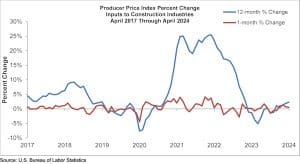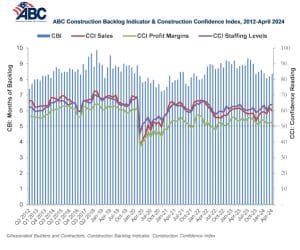US construction input prices surged in April driven by higher costs for energy but contractors remain confident of growth
Analysis of US Bureau of Labour Statistics Producer Price Index by Associated Builders & Contractors (ABC) show US construction input prices increased by 0.5% compared with March.
Non-residential construction input prices rose 0.6%.
Overall construction input prices were 2.3% higher than April 2023, while non-residential construction input prices were 2.2% higher.
Prices increased in two of the three energy subcategories last month. Crude petroleum prices were up 10.6%, while unprocessed energy materials prices rose 8.2%.
Natural gas prices were down by 0.9%.

Rising prices put pressure on profits
ABC chief economist Anirban Basu said: “Construction input prices jumped half a percentage point higher in April and have increased 3.5% over the first four months of the year.
“While iron, steel, asphalt and gypsum product prices fell in April, oil and copper prices surged, driving the monthly increase.
“Rising input prices will put pressure on profits at a time when nearly one in four contractors expect their margins to contract over the next two quarters, according to ABC’s Construction Confidence Index.
“Perhaps more importantly for contractors, the overall Producer Price Index reading for final demand goods and services increased 0.5% in April.
“This is yet another sign that inflation is accelerating and suggests that interest rates are set to stay higher for longer.”
Construction backlogs increase in April
The construction input data comes after ABC’s Construction Backlog Indicator increased to 8.4 months in April.
This was up by 0.2 from the previous month. However, the reading was 0.5 lower than April 2023.
Backlogs declined on a monthly basis for the largest and smallest contractors by revenue and grew for those with $30m-$50m and $50m-$100m in annual revenues.
On an annual basis, only contractors with $30m-$50m in annual revenues have experienced an increase in backlog.

US construction remains optimistic
ABC’s Construction Confidence Index for sales and profit margins fell slightly in April, although the measure for staffing levels improved.
All three readings remain about the threshold of 50, indicating expectations for growth over the next six months.
“The Federal Reserve began ratcheting up interest rates more than two years ago but one would not know it based on construction confidence and backlog,” Basu said.
“ABC measurements reflect ongoing momentum in the nation’s non-residential construction sector.
“While there are occasional hints of softness in certain segments and over certain periods, the average contractor continues to report solid backlog and a belief that sales, employment and profit margins will expand over the next six months.
“Time will tell whether this optimism is justified.”
Cancellations, supply chain issues and labour costs on the rise
“Coming into the year, many expected that interest rates would fall markedly in 2024. Given stubbornly elevated inflation, that will not occur, Basu said.
“Project financing costs are poised to remain higher for longer. Project cancellations and postponements have been on the rise.
“Moreover, a new set of supply chain issues has emerged, driving up materials costs and prospectively weakening industry margins.
“Workers also are becoming more expensive, in part because the construction wage premium has shrunk over the past several years due to rapidly rising compensation levels in competing segments like logistics and retail. The implication is that construction compensation levels will need to rise for the industry to be able to staff up more fully.”

